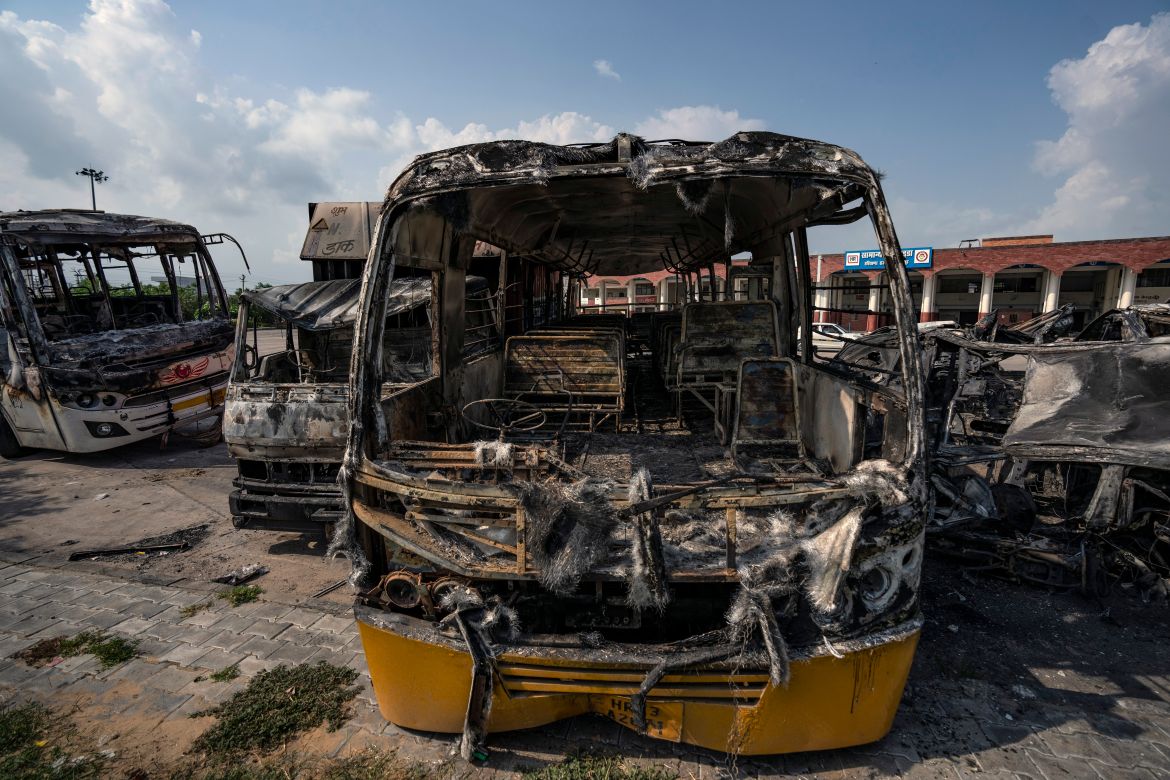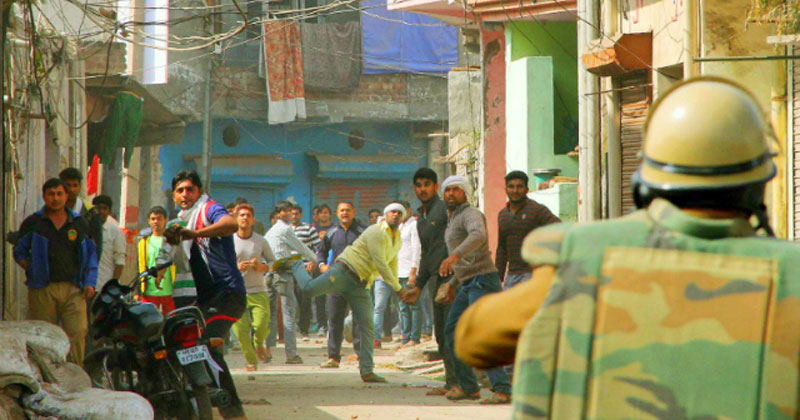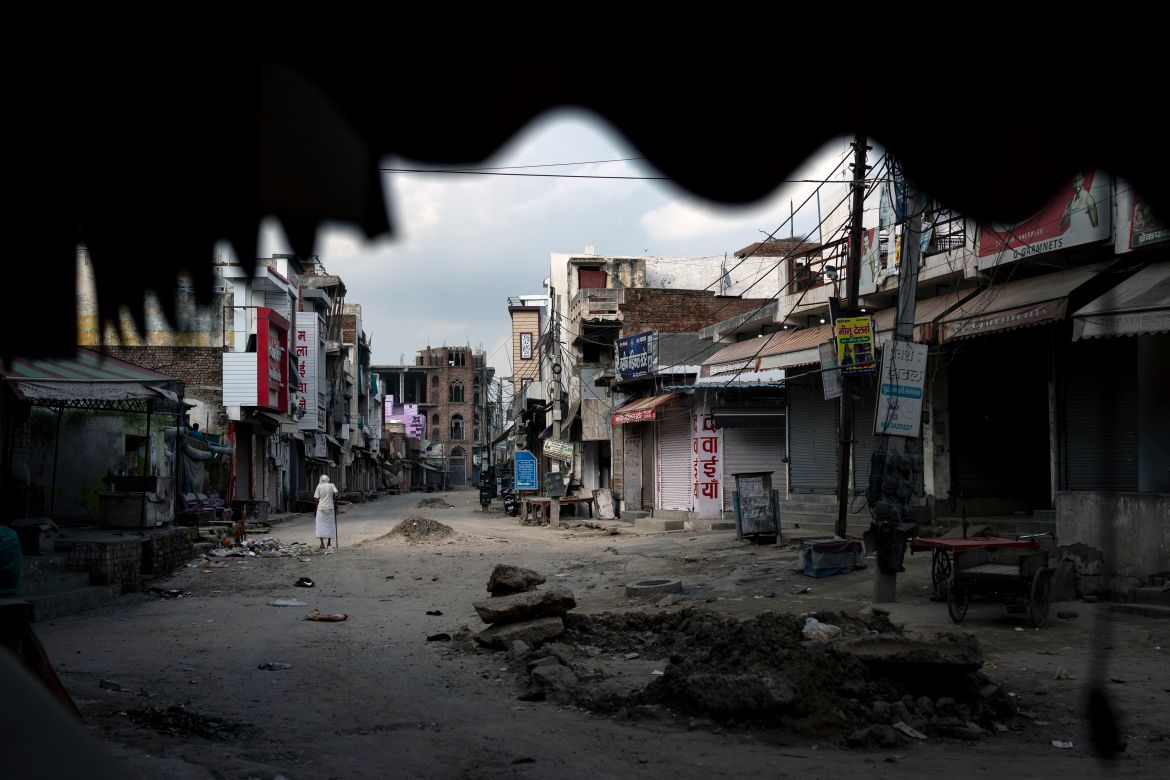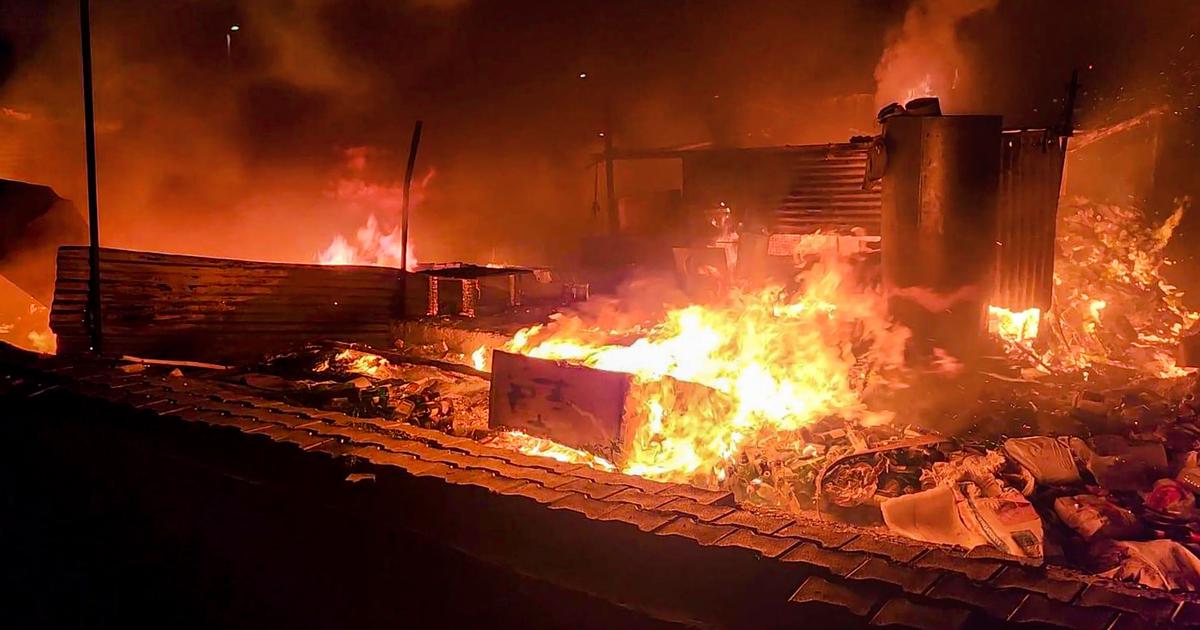Communal violence in Haryana, India erupted between Hindus and Muslims in the state of Haryana, India, during the period from July 31, 2023, killing at least 10 people, and widespread unrest in the region. The violence primarily took place in the Nuh and Gurugram districts, both locations known for religious tensions and communal strife in the past. The riots were fueled by religious differences and involved clashes between Hindu nationalist groups, particularly the Bajrang Dal and Vishwa Hindu Parishad, and the Muslim community.
What triggered the Communal violence in Haryana?
The communal violence in Nuh, Haryana, was sparked by a triggering incident that involved Monu Manesar, a suspect in the Nasir and Junaid lynching case. Monu Manesar was associated with the Bajrang Dal, a right-wing Hindu nationalist organization, and his alleged involvement in a Hindu religious procession organized by the Bajrang Dal and Vishwa Hindu Parishad became the focal point of tensions.
1. False Announcement and Rumor Involving Monu Manesar: False information circulated that Monu Manesar, wanted by the police as a suspect in the murder of two Muslim men, Nasir and Junaid, would be participating in the Hindu religious procession. The rumor created a sense of fear and suspicion within the Muslim community and among others participating in the procession.
2. Absence of Monu Manesar at the Hindu Religious Procession: Contrary to the rumors, Monu Manesar did not actually attend the Hindu religious procession. He claimed to be on a pilgrimage visiting temples across different states, including Uttar Pradesh, Haryana, and Rajasthan, during the time of the procession. Monu stated that he had not received any notice from the police, and if required, he would cooperate with the authorities.
3. The Cybercrime Crackdown in Nuh Led to Increased Tensions: Adding to the tense situation, the Nuh district was experiencing a cybercrime crackdown, which may have contributed to heightened tensions and apprehensions among various communities. The presence of law enforcement in the area could have further exacerbated the atmosphere and led to mistrust and suspicion.
These incidents triggered the ultimate fate, the communal violence in Haryana of India.
How the violence in Haryana happened?
On the 31st of July Monday afternoon, in Nuh town, the atmosphere was charged with religious fervor as a procession, comprising approximately 200 people, commenced from Edward Chowk. The participants, led by members of the Vishva Hindu Parishad (VHP), were marching in a religious rally.
Clashes erupted in Nuh, Haryana, after Muslim men halted that religious procession, leading to stone-throwing incidents. In response, authorities deployed additional troops, enforced a curfew, and suspended internet services. However, Hindu mobs continued to attack Muslim-owned establishments, including shops, eateries, and places of worship in Gurugram and nearby towns like Sohna. Bajrang Dal members conducted a rally in Bahadurgarh, Haryana, where they chanted hateful slogans, such as “Desh ke gaddaron ko, Goli maaro saalon ko” (“Shoot the traitors of our country”), reminiscent of those used by BJP politicians during anti-Citizenship Amendment Act protests in 2019 and 2020.

How minorities are being oppressed in India?
As the procession moved along its designated route, a large and aggressive crowd, with hostile intent, confronted the participants. Rocks and stones were hurled with alarming force, creating a scene of utter mayhem. The sudden onslaught caught the Hindu participants off guard, causing many to flee in fear for their safety.
Despite the initial panic, some individuals from the Hindu side quickly regrouped and decided to retaliate against the assailants. The clashes between the two groups intensified, escalating the situation into a full-fledged confrontation. Amid the turmoil, emotions ran high, and the scenes were filled with turmoil and despair.
In the midst of the violent clashes, tragedy struck as two Home Guards personnel, Neeraj and Gursevak, bravely defending the peace, lost their lives. Their selfless sacrifice and dedication to maintaining order during the unrest would be remembered with solemn reverence. Several other police officers were also injured while trying to quell the violence and protect innocent lives.
The extent of the carnage and destruction was overwhelming. Numerous vehicles were set ablaze, adding to the chaos that engulfed the streets of Nuh. The once peaceful town was now gripped by fear and uncertainty, with the echoes of the clashes reverberating through the hearts of its inhabitants.
The Escalation: Communal Violence Spreads in Nuh and Gurugram
The outbreak of violence in Nuh, Haryana, did not remain confined to that region alone but quickly spread to the neighboring district of Gurugram and other areas in the vicinity, revealing the deep communal fissures in India. The initial violence erupted in the northern state of Haryana on Monday when a religious procession organized by a right-wing Hindu organization took place in the Muslim-dominated region of Nuh. As the procession moved, it faced a large crowd that allegedly pelted rocks at them, leading to a tense situation.
Is Modi scared of India’s textbook history?
However, amidst the turmoil, the Hindu side regrouped and retaliated against the assailants, leading to clashes that intensified and quickly spread to the nearby Gurugram district, which is known as a finance and tech hub home to numerous global firms and a significant population. The violent mobs in Gurugram predominantly targeted Muslim-owned properties, setting buildings ablaze and smashing shops and restaurants. The situation in Gurugram remained tense, with mobs pelting stones and setting vehicles on fire, leading to several casualties, including two police personnel and a cleric who was inside a mosque that was set alight.
A 19-year-old deputy imam named Maulana Saad was killed in a mosque in a suburb of New Delhi, India after a mob of 150 people of far-right Hindus broke into the mosque and set the mosque on fire and opened fire. “The attackers tried to sever his head.” “There are some marks. He was shot, and there are also knife marks on his chest.” “They were shouting ‘Jai Shri Ram’ [Hail Lord Ram] and saying ‘Jab mulle kaatey jayenge, Ram Ram chillayenge [Muslims will be slaughtered in the name of Ram].”
This incident occurred hours after deadly communal violence in Haryana. This comes as Hindu far-right groups aligned with the ruling Bharatiya Janata Party (BJP) have been campaigning against Friday prayers in Gurugram. The Anjuman Mosque, where the violence occurred, was one of the few places officially recognized for holding prayers.

Numerous others were injured, and extensive damage was caused to properties and vehicles. As a response to the violence and to quell further disturbances, the Haryana government took strict measures, arresting over 110 people and imposing curfews in certain areas. The suspension of mobile internet and internet services in Nuh, Gurugram, and several other districts aimed to control the situation and maintain peace.
Unraveling the Ethnic Violence in Manipur in 2023
The clashes and subsequent escalation of violence also had an impact on neighboring regions, with protests and road blockades reported in Sohna, Gurugram. Furthermore, in Maharashtra, around 1,300 kilometers (807 miles) south of Nuh, violence erupted on a train traveling to Mumbai. A police officer opened fire on the moving train, resulting in the deaths of four people, including three Muslim passengers, further exemplifying the depth of the country’s sectarian divide.
The situation in Gurugram’s business hub remained critical, and numerous multinational companies, factories, and corporate offices closely monitored the law-and-order situation. Many companies asked their employees to work remotely or return home early to ensure safety amid concerns of continued violence.
Government Response to Escalating Violence and Misinformation
In the wake of the escalating violence and the potential threat of misinformation being spread through social media, the government took decisive actions to address the situation and ensure public safety. One of the primary measures implemented was the imposition of a ban on mobile internet and SMS services in the affected areas. This step aimed to curb the dissemination of false information and inflammatory content that could further aggravate tensions and incite violence.
In addition to communication restrictions, the government swiftly deployed thousands of paramilitary and police forces to the affected regions. Their primary objective was to control the situation on the ground, maintain peace, and ensure the safety of citizens. The presence of security personnel acted as a deterrent against potential troublemakers and helped restore law and order during the tumultuous period.
Following the riots, the government established a committee dedicated to monitoring social media posts related to the violence. The committee’s mission was to identify and prevent the spread of misinformation that might exacerbate the situation and trigger further unrest. Authorities made several arrests and detentions in connection with the clashes as part of their efforts to hold those responsible for instigating violence accountable.
What ignite Haryana Violence and its Impact on Society
The ignite of violence in Haryana and its impact on society have been deeply influenced by the history and policies of the Bharatiya Janata Party (BJP), a Hindu nationalist political party. It is essential to critically examine how the BJP’s Hindutva policy, which promotes Hindu nationalism, has contributed to communal and sectarian violence in India, including states like Gujarat, Delhi, Manipur, and Haryana.
The BJP’s roots can be traced back to the Rashtriya Swayamsevak Sangh (RSS), an organization inspired by the ideologies of Hindutva. Over the years, the BJP has embraced and propagated Hindutva, which has led to a divisive narrative and sectarian politics that polarize Indian society. This ideology places the Hindu majority at the center, marginalizing and discriminating against religious minorities, particularly Muslims.
Is the RSS a Threat to India’s Secularism?
Human Rights Watch, an independent human rights organization, has highlighted those laws and policies adopted by the Indian authorities, under the BJP’s governance, systematically discriminate against Muslims and stigmatize critics of the government. These prejudices have infiltrated key institutions, such as the police and the courts, empowering nationalist groups to target, harass, and attack religious minorities with impunity.
Notably, communal violence has been a recurring consequence of the BJP’s policy of Hindu Rashtra (Hindu Nation) by any means, including incitement to violence and hate crimes. Examples of this include the 2002 Gujarat riots, where thousands of Muslims were killed, and the Delhi communal violence of 2020, which resulted in the death of 53 people, 40 of whom were Muslim. In both instances, allegations of BJP leaders inciting violence have raised concerns about the lack of credible and impartial investigations.

Another alarming aspect is the violence perpetrated in the name of cow protection, with mobs engaging in lynching and man-slaughter incidents. Muslims, who are often targeted on suspicion of cow slaughter or beef consumption, have been the victims of such hate crimes, resulting in fear and displacement in affected neighborhoods.
The BJP’s rise to power has indeed altered the political landscape of India. The party’s control over numerous states and the central government has provided them with significant influence in policymaking and governance. However, this rise has been accompanied by a rise in communal violence against religious minorities, posing a serious threat to India’s secularism and tolerance.
The impacts of such communal violence on society have been severe. It has led to deep divisions and heightened religious polarization, creating an atmosphere of fear and insecurity among minority communities. Incidents like those in Gujarat, Delhi, Manipur, and Haryana have left scars on the affected communities, with fear and displacement being prevalent. The government’s failure to protect minorities from violence and its reluctance to hold perpetrators accountable have further eroded trust in the authorities.
Bharat Jodo Yatra: Uniting India for a Stronger Future
It is crucial to address these issues seriously and work towards fostering an inclusive and harmonious society where all religious and ethnic communities feel safe and respected. The government needs to ensure equal protection of the law for all citizens and take concrete actions to prevent and respond to communal violence effectively. Only by upholding the principles of secularism and pluralism can India truly fulfill its democratic potential and promote social cohesion among its diverse population.
India’s Secularism is under Threat!
The 2023 Haryana riots have shed light on the deep-rooted religious tensions and communal issues prevailing in India. These riots, marked by violence and destruction in Nuh and Gurugram, have once again exposed the destructive impact of the Hindutva ideology propagated by organizations like the Rashtriya Swayamsevak Sangh (RSS), Bharatiya Janata Party (BJP), and its affiliated groups like Bajrang Dal and Vishwa Hindu Parishad.
Secularism, which forms the backbone of India’s democratic fabric, is being threatened by the Hindutva ideology that seeks to establish India as a majoritarian nation-state rather than a multicultural one. The tensions between these competing visions of Indian nationhood have intensified in recent years, especially since the BJP’s ascent to power in 2014.
The Bajrang Dal, the militant youth wing of the Vishva Hindu Parishad (VHP), is actively involved in promoting Hindutva ideology. This ideology, coupled with divisive discourses and policies associated with civilizationist, populism, has resulted in the emotional division of society into “the people” versus “the Other,” leading to inter-communal conflict and violence.
Secular India and the Nature of its so-called Secularism

The government’s response to the Haryana riots, including arrests and internet bans, underscores the need for swift action and preventive measures to address such outbreaks of violence. However, it is equally crucial to address the root causes of communal tensions and religious animosity. The focus should be on fostering dialogue, promoting understanding, and fostering unity and communal harmony among different religious communities.
Promoting a non-discriminatory, conciliatory, and tolerant stance towards all sections of Indian society is vital in preventing such violent incidents in the future. The government must work towards restoring the secular nature of the state, ensuring that all citizens, regardless of their religious affiliation, are treated equally and provided with equal opportunities.
India’s diversity is one of its greatest strengths, and preserving this diversity and coexistence is paramount for the country’s progress and prosperity. By actively countering the forces of communalism and religious intolerance, India can pave the way for a more peaceful, inclusive, and harmonious society for all its citizens. In conclusion, the 2023 Haryana riots serve as a wake-up call for the country to confront the challenges posed by religious extremism and divisive ideologies. To protect and strengthen secularism, India must prioritize dialogue, understanding, and unity among its diverse religious communities, working towards building a society where all citizens can live with dignity, respect, and harmony. Only through collective efforts can India rise above the destructive influences of communal violence and uphold its values of secularism and inclusivity















